






Every composite part ever made started with a mold. Yet despite all our advances in materials, automation, and design software, we're still making molds the same way we did 30 years ago – machining them from massive aluminum blocks at astronomical costs with lead times measured in months, not days.
In composite manufacturing, tooling represents a significant portion of project cost and time. In the aerospace sector, a single mold can range between $150,000 and $500,000. For wind energy applications, blade molds often exceed $1 million, while even smaller drone molds can cost $50,000 or more.
These molds also come with long lead times — typically 12 to 20 weeks — before production can even begin. And when design changes arise after testing, manufacturers often face the challenge of starting over: new tooling, new costs, and additional months added to the schedule.

This traditional approach creates three fundamental limitations that slow down the pace of innovation. First, the cost barrier prevents experimentation. When each mold iteration costs hundreds of thousands of dollars, limiting the ability to refine designs and explore innovative concepts.. Secondly, long lead times can make it difficult to stay competitive. By the time a traditionally machined mold is ready, others may already be moving ahead with production. Additionally, the limited flexibility of conventional tooling often restricts design evolution. Even when opportunities arise to improve performance, existing molds can make it challenging to implement those enhancements without significant reinvestment.
Across the composites industry, these challenges translate into significant financial and innovation setbacks. High tooling costs can make promising projects economically unfeasible, while many design innovations never progress beyond the CAD stage due to the difficulty of justifying new mold investments. As a result, companies often continue relying on established designs, not because they lack better ideas, but because the cost and time of retooling remain major barriers.
At Addcomposites, we saw that this wasn't just a manufacturing issue—it was an innovation roadblock limiting what industries could achieve.. That's why we developed SCF3D (Continuous Fiber 3D Printing) technology, transforming mold making from a capital-intensive, months-long ordeal into a rapid, cost-effective process that finally matches the pace of modern product development.
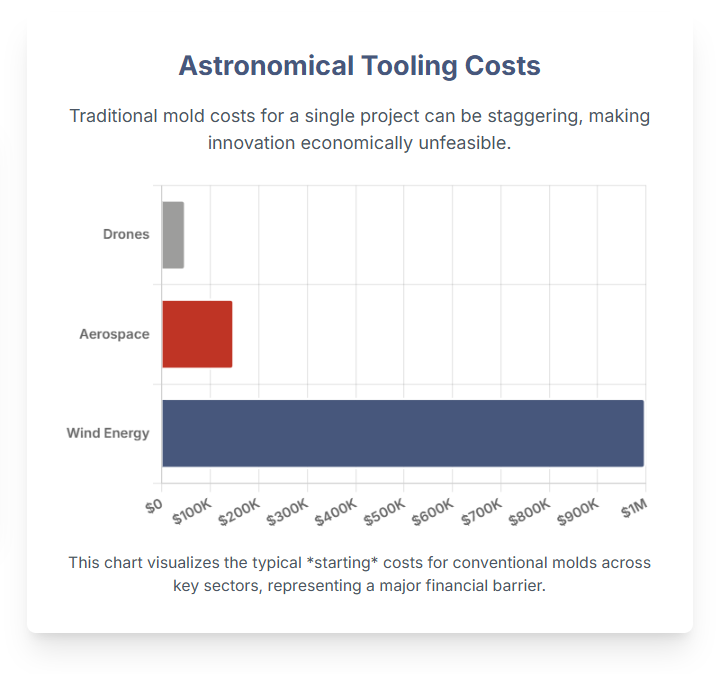
SCF3D represents a fundamental reimagining of how composite molds are created. Instead of removing material from solid blocks, we're building molds layer by layer with continuous fiber reinforcement, achieving mechanical properties that rival traditional aluminum tools at a fraction of the cost and time.
The core innovation lies in our continuous fiber deposition system. Unlike conventional 3D printing that uses short or chopped fibers, SCF3D lays down unbroken strands of carbon, glass, or aramid fiber within a polymer matrix. These continuous fibers carry loads along their entire length, providing strength and stiffness exactly where needed. Think of it as weaving a basket, but with carbon fiber and aerospace-grade precision.
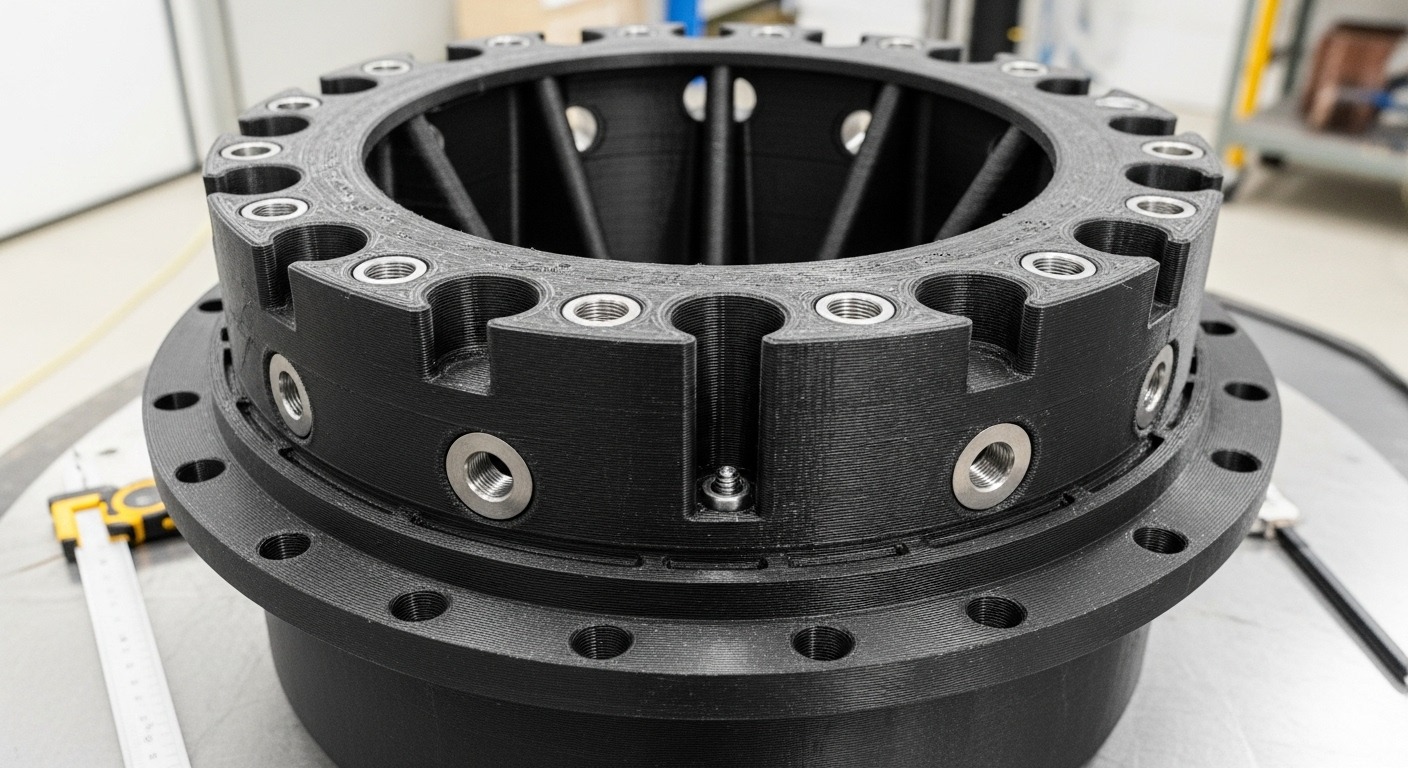
Our system achieves remarkable mechanical properties through precise fiber control. The print head can vary fiber orientation layer by layer, creating quasi-isotropic laminates or highly directional reinforcement based on load requirements. Typical SCF3D molds deliver tensile strength
SCF3D molds demonstrate excellent thermal performance, ensuring consistent and efficient processing. Continuous carbon fibers conduct heat along their length, creating thermal highways that accelerate heating and cooling. We've seen reduction in cure cycle times compared to traditional tools. The tailored fiber architecture also minimizes thermal expansion, maintaining dimensional stability through repeated thermal cycles up to 200°C.
What truly sets SCF3D apart is its integration with the complete Addcomposites ecosystem. The same AddPath software that controls our AFP systems manages the entire mold's printing process. Path planning, fiber steering, temperature control, Slicing – everything runs through our unified platform. The digital twin functionality provides real-time quality assurance, tracking every meter of fiber placed and flagging any anomalies before they become problems.
Material flexibility opens up a new level of design freedom. Whether the goal is high-temperature durability with PEEK, visual access with glass fiber and clear resin, or maximum stiffness with full carbon fiber reinforcement — the process adapts seamlessly. Materials can even be combined within a single mold: carbon fiber in high-stress zones, glass fiber for structure, and pure polymer where load demands are low.
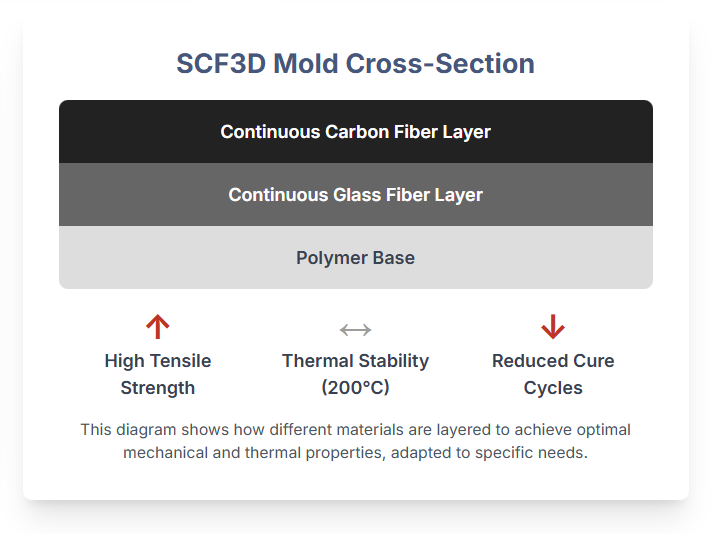
The aerospace sector perfectly illustrates both the opportunities and the challenges of composite manufacturing.. Components demand exceptional surface quality, tight tolerances, and absolute repeatability. Aerospace manufacturers often face long lead times and high tooling costs, with molds taking several months to produce and representing a major share of project expenses.
Consider satellite dish antenna manufacturing. The parabolic structures require precise surface geometry for signal focus, smooth finishes for RF performance, and dimensional stability across temperature extremes. Traditional machined aluminum molds demand substantial time and money. Long lead times and high replacement costs make quick design iteration difficult, locking designs into the initial geometry unless a significant reinvestment is made.
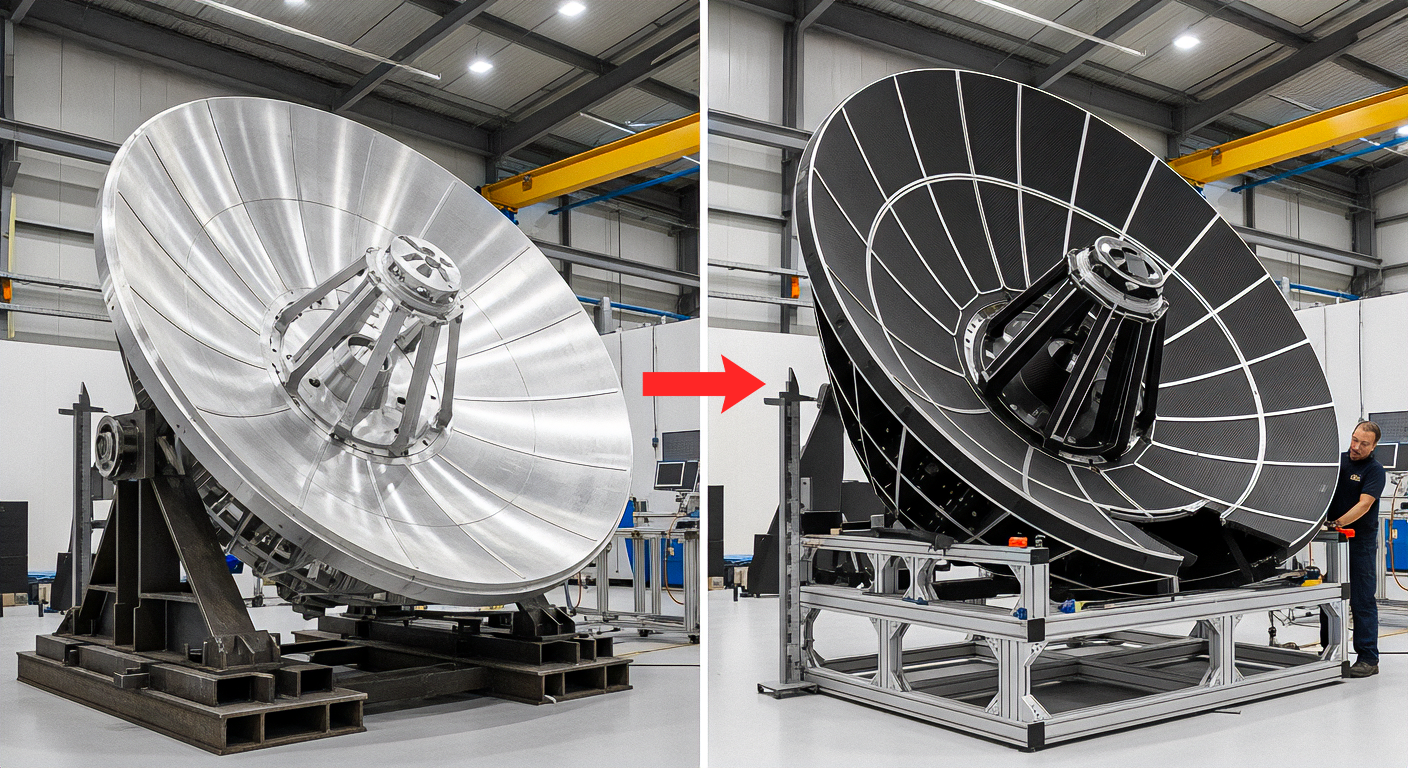
SCF3D transforms this equation completely. The technology enables rapid production of antenna reflector molds. With continuous fiber reinforcement, these molds can achieve the stiffness required to maintain parabolic accuracy under autoclave pressure. Surface quality after the post process can achieve the smoothness required for RF performance. The continuous carbon fiber reinforcement provides exceptional dimensional stability through cure cycles.
The real advantage lies in design iteration capability. When antenna testing reveals optimization opportunities, engineers can modify CAD models and produce new molds within days rather than months. Traditional tooling would require complete re-investment and extended delays. With SCF3D, multiple design iterations become feasible within typical development timelines, enabling performance improvements that would otherwise be economically impossible.
UAV manufacturers face similar challenges with aerodynamic fairings, structural frames, and control surfaces. These components often feature complex compound curves, integrated mounting points, and precise thickness control. SCF3D molds handle this complexity effortlessly.. Threaded inserts for demolding integrate during printing. Surface textures for stealth applications generate automatically from CAD data.
The numbers demonstrate the potential transformation. Aerospace companies producing composite parts typically invest hundreds of thousands in traditional tooling with multi-month lead times. SCF3D technology can reduce tooling costs with dramatically shortened turnaround times. Custom aerospace components become more economically viable. Low-volume production makes better financial sense. Rapid prototyping transitions from aspiration to reality.

Wind energy presents unique mold making challenges. Blade molds stretch dozens of meters, must maintain precise aerodynamic profiles, and endure thousands of production cycles. Traditional manufacturing approaches these demands with massive steel or composite molds costing millions of dollars and requiring dedicated facilities just for storage.
The small wind revolution (turbines under 100kW) desperately needs cost-effective tooling solutions.
SCF3D democratizes wind blade production. Using our modular approach, manufacturers can print mold sections that bolt together into complete tools. Each section optimizes for local requirements – high-strength carbon fiber where mechanical loads peak, standard glass fiber for general structure. The assembled mold maintains tolerance across its full length while potentially costing 90% less than traditional alternatives.

This modular approach is particularly valuable for small wind manufacturers targeting agricultural or distributed energy markets. Eight-meter blades that traditionally require $350,000+ molds with 20-week delivery times become feasible with SCF3D technology. The printed molds can be produced in a matter of days rather than months, enabling faster market entry and design validation.
Surface quality meets industry standards. After post-processing , SCF3D molds can achieve desirable surfaces suitable for professional blade production. The continuous fiber reinforcement prevents print-through and maintains profile accuracy. With proper material selection and processing, these molds demonstrate excellent durability through repeated cure cycles.
The technology scales remarkably. While we're printing 15-meter sections today, the modular approach theoretically enables molds of any length. Joints between sections use precision alignment features printed directly into each module. The assembled tool acts as a monolithic structure with no compromise in blade quality.
Beyond cost reduction, SCF3D enables rapid design optimization previously impossible in wind energy. Manufacturers can test multiple blade profiles, iterate based on wind tunnel data, and implement improvements without massive tooling investments. The ability to modify designs based on performance data fundamentally changes how blade development occurs.
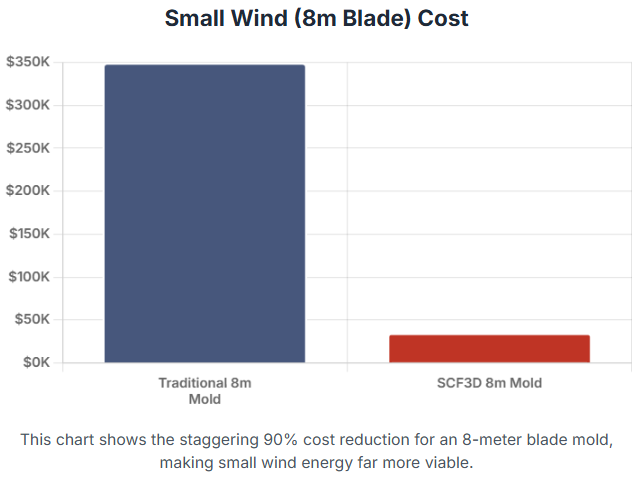
The drone industry moves at silicon valley speed. Product cycles measured in months. Design iterations weekly. Production volumes that spike from hundreds to tens of thousands based on market response. Traditional tooling methods are limited in their ability to support rapid design and production cycles.
The racing drone sector demonstrates the demanding balance between strength, weight, and agility. Lightweight frames must endure repeated impacts, and aerodynamic shells often involve intricate geometries. Production quantities shift rapidly with competition timelines and evolving regulations.
With SCF3D technology, drone manufacturers gain true manufacturing flexibility. Mold sets can be produced within days rather than weeks, supporting fast design iterations. Adjustments to meet new dimensional or regulatory requirements can be implemented immediately, while on-demand production helps eliminate excess tooling and inventory costs.

Agricultural and industrial drone applications showcase this flexibility particularly well. These manufacturers need to produce fuselage shells with integrated sensor mounts, cable routing, and crash protection structures. Traditional five-axis machining for such complex molds typically costs tens of thousands with multi-week delivery times. Design changes require complete re-machining.
With SCF3D technology, complete mold sets can be printed within days rather than weeks at a fraction of traditional costs. Continuous fiber reinforcement provides the mechanical strength needed for vacuum bagging and ensures smooth aerodynamic surfaces. Design updates identified during field testing — including sensor relocation, vent additions, or structural reinforcements — can be implemented rapidly, with new molds ready in just a few days.
SCF3D technology simplifies production scaling. From pilot runs to full-scale manufacturing, additional molds can be printed on demand, eliminating the need for costly aluminum tooling. This flexibility enables efficient responses to changing production volumes without financial or scheduling constraints.
SCF3D enables mold geometries that go far beyond the capabilities of conventional tooling. Material-efficient, topology-optimized designs maintain mechanical integrity while reducing weight and cost. Conformal cooling networks enhance thermal management and shorten cycle times, while embedded sensors enable in-process monitoring and continuous improvement.
SCF3D allows drone manufacturers to innovate without production constraints. Continuous design optimization, rapid response to feedback, and scalable production become integral parts of the development process. Tooling evolves from a fixed asset into an enabler of agility and creativity.
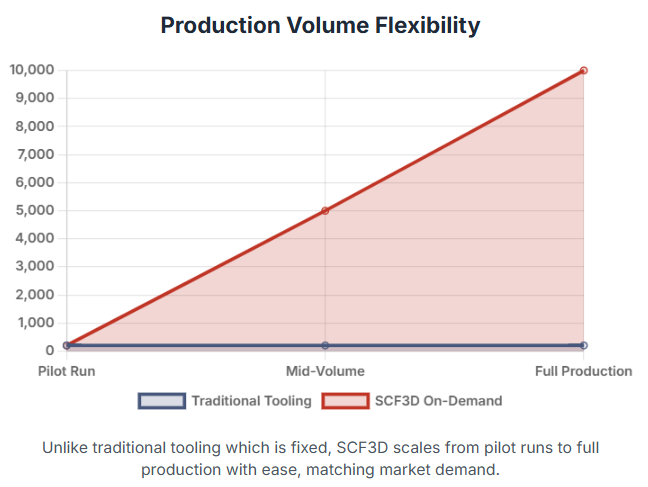
SCF3D represents the next step in composite manufacturing efficiency. It accelerates design iteration from months to weeks and significantly reduces tooling costs, allowing manufacturers to focus investment on performance improvement and market expansion.
The Addcomposites ecosystem aligns with existing design workflows. AddPath software handles everything from CAD data import to mold preparation, supported by digital twin technology for full process traceability. It supports STEP files from major CAD platforms including CATIA, Siemens NX, and SolidWorks, enabling straightforward interoperability.
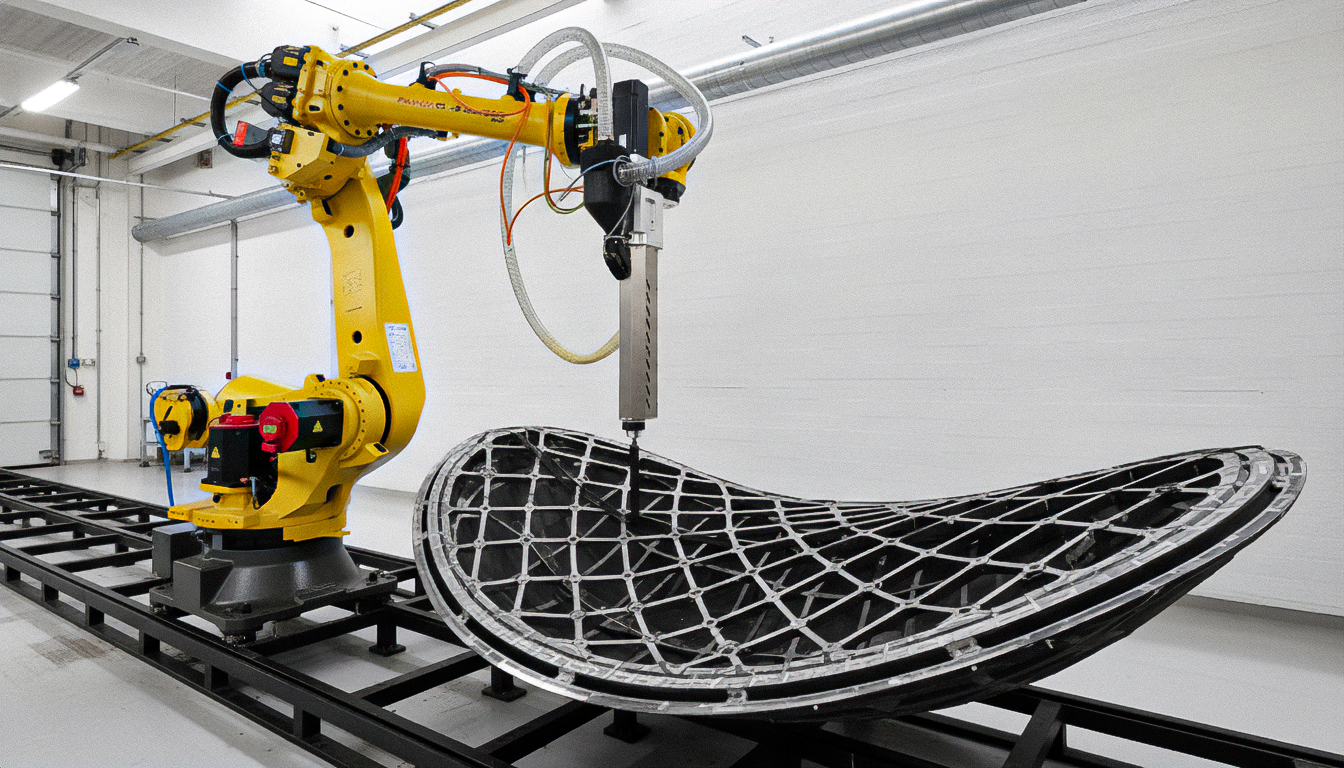
Implementation is straightforward – most customers produce their first production-quality parts within one week of system installation. With support and comprehensive training, your team transitions smoothly from traditional to advanced mold making.
The SCF3D Advantage:
Ready to revolutionize your composite manufacturing?
📧 Email: info@addcomposites.com
📞 Call: +358 (0)503 305 201
🌐 Book Demo: Request Demo
💼 LinkedIn: Connect with our specialists
🚁 Start Your Revolution Today → www.addcomposites.com
Special Offer: Schedule your consultation before December 31st for a complimentary feasibility study of your most challenging mold design.
Don't let traditional mold making constraints limit your future. Contact Addcomposites today.
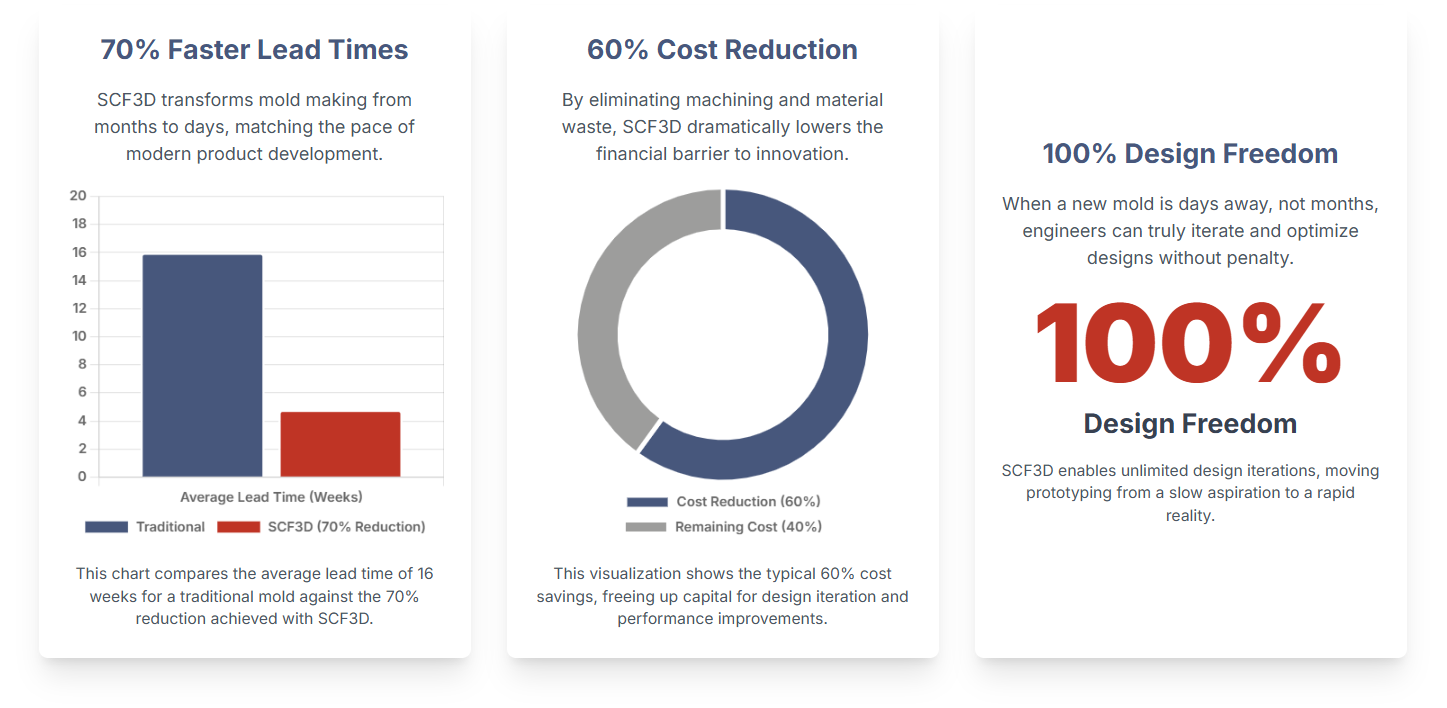
Addcomposites – Democratizing Composite Manufacturing